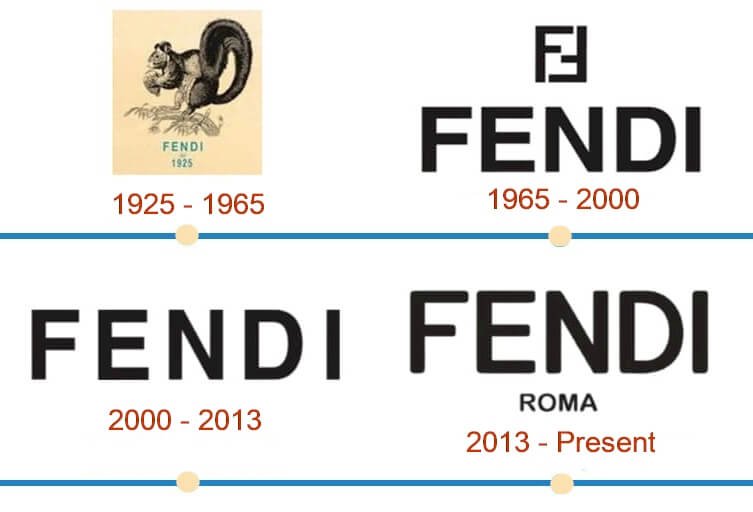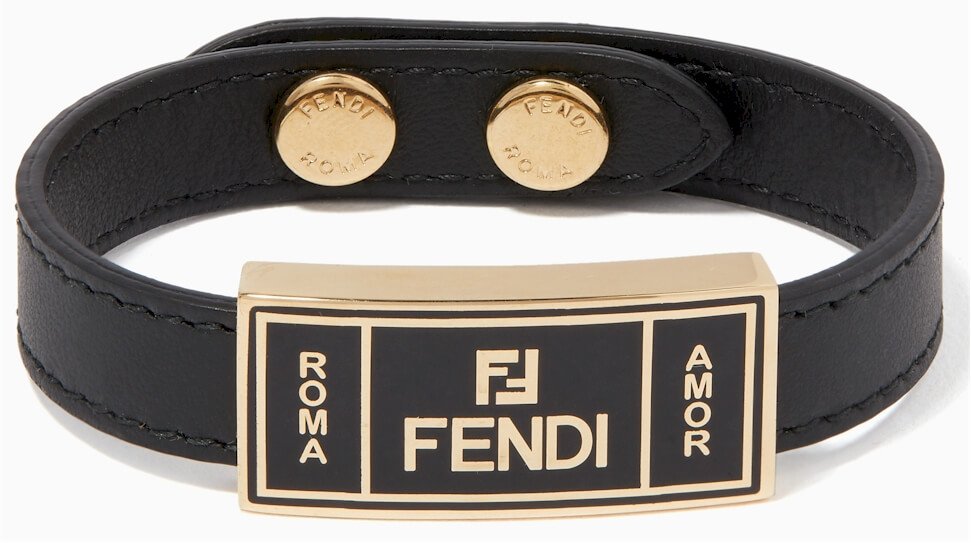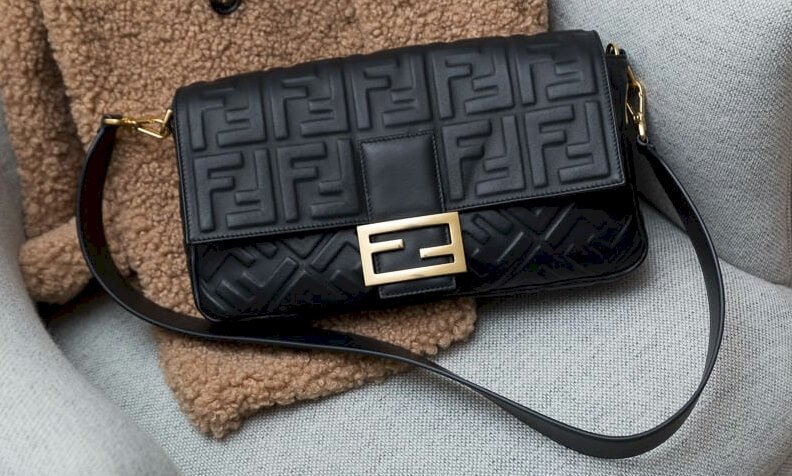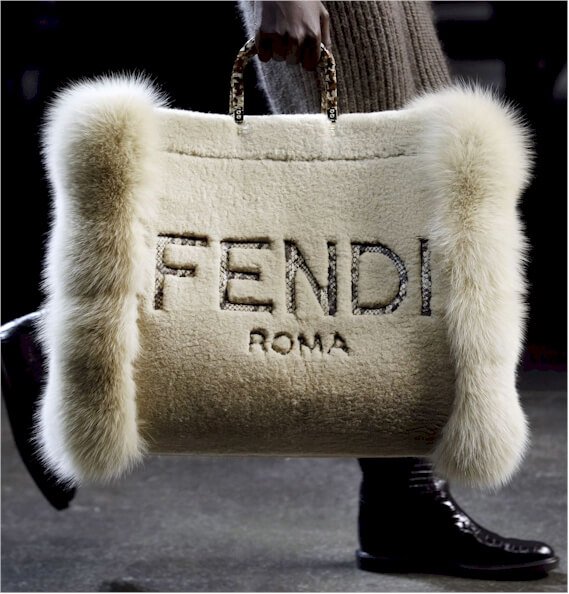The Fendi logo is a legendary one. In fact, it outdoes the brand itself and takes a life of its own. The double “F” symbol has become so famous that people who don’t know anything about the Fendi brand are still familiar with it.
So what’s the history of the Fendi logo? And what are its design elements? Keep reading to learn a lot more about this iconic logo and brand.
The Fendi Logo History and Evolution

The Fendi logo is renowned worldwide, with its double “F” monogram attaining iconic status. But the original emblem of the luxury fashion house is far removed from the solid bold inscription we see today.
1925 — 1965
Designed in 1925, the first-ever Fendi logo had the image of a squirrel holding a nut while standing delicately on a branch. This was quite an unusual symbol for a fashion label. The logo was a mascot with meaning for the founders. Eduardo Fendi gifted his wife Adele a squirrel painting as he always said she was as busy as a squirrel.
The inscription was placed below the image in a strict sans-serif uppercase font and featured the “1925” date as a slogan. Both sides of the logotype were rendered in turquoise blue, which appeared very refined on the brand’s bright yellow wrapping paper.
1965 — 2000
In 1965, Karl Lagerfeld joined Fendi and soon changed its logo. He created the iconic double “F” symbol in a matter of seconds, with the black logotype beneath written in a tall, solid, straight uppercase sans-serif font.
2000 — 2013
In 2000, the “FF” symbol was removed from the official version of the Fendi logo and started being used mainly for prints on the fabrics and leather. As for the brand’s visual identity, it was now composed of a single capitalized inscription in a refined sans-serif typeface with the letters having a huge space between each other, making the logo airy and light despite the thickness of the letter’s lines.
2013 — Present
The Fendi logo redesign of 2013 altered the font into a smooth rounded one. Today, its uppercase letters are rendered in a font closely resembling the Basic Commercial Soft-Rounded Pro Bold font, with smooth, sleek lines but classic solid shapes.
A delicate slogan, “ROMA,” complements the vast logotype in the same font but smaller. The slogan celebrates Rome, the brand’s home city, which is also its key inspiration.
Fendi symbol

Apart from the double “F” inscription, which is also called inverted “Zucca,” Fendi has a script emblem. The Fendi font used on the inscription is Helvetica Bold. Interestingly enough, the “F” on the Fendi symbol is not the same one featured on the script emblem.
Logo Bags
The Fendi logo features Fendi bags in many different ways, with the clasp being the most obvious place. While it’s the most attractive place for the emblem, it isn’t the only one.
In some bags, the double “F” emblem creates a pattern on the material. In this case, the symbol is replicated countless times. And, of course, the pattern is repeated on the inner lining.
Logo Bracelet

The Fendi emblem bracelets vary in material, structure, and width. Wide metal bracelets featuring a big double “F” symbol are quite popular. You can also find a wide white bracelet featuring a black logotype that reminds you of a stencil.
Fendi also offers chain bracelets, which feature the logotype on the charms. When it comes to leather bracelets, the logo often features on the clasp.
Design Elements of the Fendi Logo

Shape: The double “F” Fendi symbol (also called the inverted “Zucca”) is one of the most iconic logos in the world of fashion today. It was designed in 1965 by a young Parisian graphic designer named Karl Lagerfeld. The logo is featured on a wide range of Fendi items, including clothing, shoes, handbags, wallets, and bags.
While Fendi is one of the world’s most valuable fashion houses, it has the unenviable distinction of having one of the world’s most counterfeited logos.
Font: The Fendi logo features the brand name in capital letters written in the Helvetica Bold font.
Color: The Fendi logo uses black, which symbolizes the elegance, dominance, and supremacy of the luxury fashion brand, while yellow signifies joy, happiness, and optimism.
The History of Fendi
The Fendi brand is the byword for luxury. The Italian fashion label is renowned not only for its distinctive double “F” logo but also its audacious bags made with perfect precision. For almost a century, the fashion brand has always been looking ahead, inspiring its creative designers to come up with newer, more original products, all while keeping its collections more affordable and inspiring for its devoted customers.
Still, under the control of the Fendi family, Fendi is the same brand that a young Karl Lagerfeld stood out in as artistic director, bringing the brand to everyone’s attention and showing the masses how different and stunning some materials can look. That said, let’s take a little stroll down memory lane and find out how this fashion label started out.
Fendi’s Origins
Eduardo Fendi and his wife Adele Fendi started this fashion label back in 1925 in Rome, Italy. Since its launch, Fendi has always been synonymous with opulence and luxury. The brand started out with manufacturing leather products and quickly moved into making fur products—two products Fendi is still renowned for today.
Also, Fendi was a family business since day one, with Eduardo and Adele’s five daughters being greatly involved with everything, from coming up with innovative new ideas to helping sell the luxury items to excited consumers, who were seeking stylish items to add to their wardrobe collection.
In 1946, Eduardo died, and his wife and daughters kept the business going. What started out as a fashion label focused on beauty and innovation has stayed true to its roots and never deviated from that.
Karl Lagerfeld Joins Fendi
In 1965, Karl Lagerfeld was welcomed to Fendi. As creative director, Lagerfeld came up with the idea of the iconic double “F” emblem—which is actually short for Fun Furs.
While many fashion houses today don’t support fur sales, it was an in-demand material at the time. Lagerfeld pushed Fendi forward into the fur business, making the brand one of the top manufacturers of fur items.
Instead of using fur for making fur coats only, Lagerfeld decided to use the material for ready-to-wear designs, accessories, and anything else that came to his mind. This made fur products more affordable for the average Fendi customer and gave the material a whole new purpose.
Lagerfeld also worked hand in glove with the Fendi family’s daughters to continue to come up with original Fendi goods. The daughters were still influential and heavily involved in the day-to-day running of the business at this point.
The designs got even more innovative, and they started to incorporate plenty of colors, making the brand’s products even more desirable and unique. While fur had hitherto been an exclusive purchase—a preserve of the rich and famous—the creatives at Fendi took “lower-quality” fur and reworked it into something that the average Fendi customer would afford. This allowed the brand to set more affordable prices, too.
In 1977, Lagerfeld also oversaw Fendi’s launch of ready-to-wear pieces, following it up with a shoe line in 1978. Still, in the 1970s, Fendi also rolled out a variety of artisan collections to relentlessly expand the fashion house, with leather and fur items always leading the way.
The Fendi Brand’s Evolution
Adele Fendi passed on in 1978, triggering changes in the brand’s hierarchy. Each of the five Fendi daughters took over some part of the fashion label, with Lagerfeld remaining the head of the creatives. Fendi continued to grow and evolve, setting the pace in the luxury fashion market, continuously innovating but still maintaining its Italian origins.
The 1980s was a game-changing period for Fendi—it saw the brand take the world fashion market by storm. The fashion label also launched men’s and women’s scents and made uniforms for Rome police officers. In the late 80s, the first Fendi store in the U.S. popped up on New York’s Fifth Avenue, with the Fendi granddaughters also involved in running the business. They helped design new items and grew the brand even further.
The Fendi Baguette

The Fendi Baguette is probably the most popular of all Fendi designs. The bag, designed by Silvia Fendi in 1997, started a handbag revolution for the fashion label. A host of celebrities snapped up the bags as soon as they could, including Naomi Campbell, Madonna, and many others.
The simple, fashionable bag came in various selections and inspired more legendary Fendi designs that came up in the following years. The Baguette remains one of Fendi’s most coveted bags and is one of the best-selling pieces from the brand’s entire design collection.
Today, the Baguette can be seen in the arms of many fashionistas worldwide. And ever since the Baguette was designed, there have been more than a thousand versions! It’s said that Baguette’s success is actually what made LVMH want to buy shares in Fendi. Other famous Fendi bags include the Roll Bag, the Ostrich Bag, and the Biga Bag, all designed between 1999 and 2003.
LVMH Takes Over Fendi
In 1999, Fendi was acquired by LVMH and Prada, with the chairmen of both fashion labels taking a majority stake. But despite the sale, Fendi remained under the management of the Fendi family’s third-generation daughters.
Silvia Fendi worked with Karl Lagerfeld for more than 20 years until Karl’s death in 2019. Following his death, she took over the creative director role the same year. She is known mainly for creating some of the world’s most iconic bags. She went for lightness, practicality, and functionality in the bags.
Kim Jones Joins Fendi

Fendi has continuously gone from strength to strength, always staying faithful to its Italian origins and putting the Fendi women in charge.
Eduardo and Adele’s granddaughter, Silvia Venturini Fendi, eventually took over the artistic management of the Fendi accessories range (prompting her Baguette design) as well as the menswear collection. But in 2020, Fendi recruited Kim Jones as the artistic head of fur, ready-to-wear, and haute couture collections for women.
According to Women’s Wear Daily, Jones is working closely with the Fendi granddaughters, particularly Silvia, who’s still influential in the brand. He’s the first individual outside of the Fendi clan to join the label in a key role since Karl Lagerfeld, whom the brand honored in 2019 following his passing with its fall couture fashion show in Rome.
The fashion house not only paid tribute to its Rome origins, but the whole show was in honor of Lagerfeld as well as his legacy with Fendi. It’s was the best way to thank Lagerfeld for all his contributions to Fendi’s success while keeping the brand looking well ahead into the future.
Fendi Today and into the Future

Like numerous other fashion labels, Fendi aims to become even more environmentally conscious, making use of recycled materials and wanting to generate less waste. But while Prada has vowed to stop using fur, Fendi doesn’t intend to stop using the material as of yet.
While being interviewed by Women’s Wear Daily, Antoine Arnault, the head of the environment, communications, and image at LVMH, reiterated the company’s desire to become more eco-conscious going forward. Time will eventually tell if they will keep their word.
Summing the History of Fendi
Fendi is a renowned Italian fashion label that was established by the husband and wife duo of Eduardo Fendi and Adele Fendi in 1925. Majorly owned by the French multinational conglomerate LVMH, the firm specializes in luxury fashion, and its signature Baguette Handbag is one of the most sought-after fashion items.
The LVMH Group majorly owns Fendi, but the Fendi family’s granddaughters, led by Silvia Venturini, continue to oversee its daily operations. Silvia is in charge of designing women’s and men’s apparel and many other accessories.
Fendi is still headquartered in Rome, Italy, the place where it all began almost 100 years ago. We are certain that the Fendi logo and brand will continue to spring surprises upon its customers with wonderful fashion items and, needless to say, more iconic bags.







